-
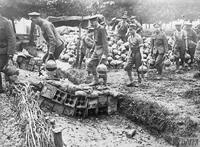 [Untitled]
[Untitled] Gunners of the Royal Garrison Artillery carrying trench mortar ammunition to the trenches. Acheux, 28th June 1916.
-
 [Untitled]
[Untitled] Camouflaging a shell dump, 29 July 1916
-
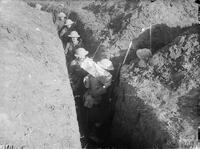 [Untitled]
[Untitled] Cameron Highlanders, walk through in a narrow communication trench, situated between Pozieres and Le Sars, in the region of the Battle of the Somme, October 1916. One Highlander carries a box of grenades over his shoulder.
-
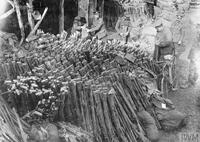 [Untitled]
[Untitled] British troops stacking salvaged Lee Enfield rifles at Aveluy, September 1916. These would be sent back to base, stripped and cleaned and reissued.
-
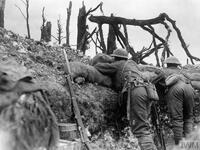 [Untitled]
[Untitled] British troops observing from a trench near Thiepval, September 1916.
-
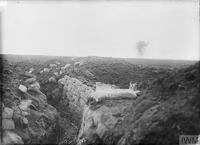 [Untitled]
[Untitled] British shells bursting on German trenches near Courcelette, taken South of Pozieres, 20th September 1916.
-
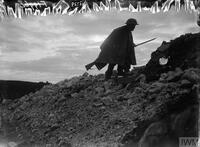 [Untitled]
[Untitled] British sentry going up to his post; near Beaumont Hamel, July 1916.
-
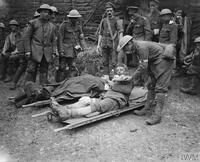 [Untitled]
[Untitled] Battle of the Ancre. British wounded at a Dressing Station. Aveluy Wood, 13 November 1916.
-
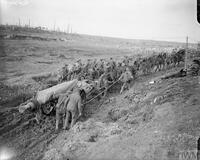 [Untitled]
[Untitled] Battle of Tansloy Ridges. A 60 pounder gun being moved forward with difficulty by troops of the Royal Field Artillery and horses near the village of Bazentin le Petit. October 1916.
-
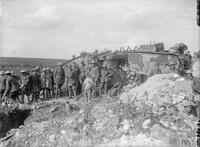 [Untitled]
[Untitled] Battle of Flers-Courcelette. A Brigadier and his staff outside Tank 17 of D Company, which was used as his Headquarters. Near Flers, 21st September 1916.
-
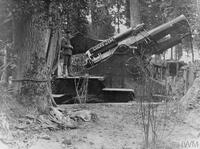 [Untitled]
[Untitled] Battle of Albert. 12-inch howitzer named 'Lucky Jim' in action. 1st July 1916.
-
 [Untitled]
[Untitled] Two soldiers cooking in a trench at Ovillers with a scrounged stove. July 1916.
-
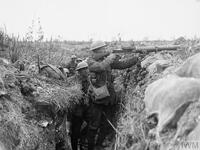 [Untitled]
[Untitled] A Lewis light machine gun in action in a front line trench near Ovillers. Possibly troops of the Worcestershire Regiment of the 48th Division.
-
 Tending a grave near Mametz Wood, August 1916
Tending a grave near Mametz Wood, August 1916 Tending a grave near Mametz Wood, August 1916.
Mametz Wood on the Somme was attacked by the 38th (Welsh) Division on 7 July 1916. The shell-blasted wood was heavily fortified with machine guns, trenches and mortars. During five days of bitter fighting the division suffered nearly 4,000 men killed or wounded. Although most of the wood was cleared of the enemy on 12 July, fierce German counter-attacks continued in the days that followed. Many of the dead were buried in a temporary cemetery nearby.
-
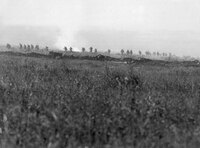 [Untitled]
[Untitled] An assault battalion of the 103rd (Tyneside Irish) Brigade advance shortly after zero hour on 1 July during the Allied attack on La Boisselle. The 3,000-strong brigade attacked across Mash Valley but was caught by German machine-gun fire in no-man's land, sustaining over 1,900 casualties during the day.
-
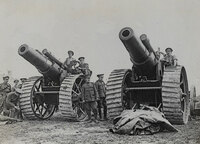 [Untitled]
[Untitled] Howitzers of 135th Siege Battery on the Somme, 25 August 1916. The 8-inch howitzer had a range of about 12,300 yards (11.24 km), and fired a 200lb (90.8 kg) shell. Most heavy artillery weapons were used by units of the Royal Garrison Artillery, whereas the Royal Field Artillery tended to use lighter guns that were mobile.
-
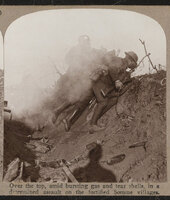 Over the top, amid bursting gas and tear shells, in a determined assault on the fortified Somme villages'
Stereoscopic photograph
Over the top, amid bursting gas and tear shells, in a determined assault on the fortified Somme villages'
Stereoscopic photograph While photographers were active at the Front, many scenes were staged for film and still photography.
At 7.30 am on 1 July 1916, 14 British divisions attacked on the Somme. In most cases they were unable to keep up with the artillery barrage that was supposed to take them through to the German trenches. This gave the Germans time to scramble out of their dugouts once the ineffective barrage had lifted, man their trenches and open fire. General Sir Douglas Haig's infantry were welcomed by a storm of machine-gun, rifle and artillery fire and suffered nearly 60,000 casualties during the day. Although the French had made good progress in the south and there had been some local successes, in most places the attack was a bloody failure.
Stereographs consist of two identical photographs paired in such a way that when seen through a special viewing instrument, a stereoscope, they appear as a three-dimensional images. By 1899 the photographs were mounted on thick card that was given a slight curvature to increase the illusion of depth.
-
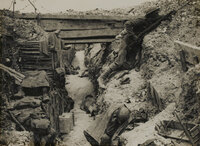 [Untitled]
[Untitled] A trench interior near the Albert-Bapaume road on the Somme, July 1916. Men of the 11th Battalion, The Cheshire Regiment, man a trench near La Boisselle. The 11th Battalion was part of 34th Division and suffered very severe casualties during its part in the attack on La Boisselle during the opening phase of the Somme offensive.
-
 Your Motherland Will Never Forget
Your Motherland Will Never Forget British Propaganda for World War I
 [Untitled] Gunners of the Royal Garrison Artillery carrying trench mortar ammunition to the trenches. Acheux, 28th June 1916.
[Untitled] Gunners of the Royal Garrison Artillery carrying trench mortar ammunition to the trenches. Acheux, 28th June 1916. [Untitled] Camouflaging a shell dump, 29 July 1916
[Untitled] Camouflaging a shell dump, 29 July 1916 [Untitled] Cameron Highlanders, walk through in a narrow communication trench, situated between Pozieres and Le Sars, in the region of the Battle of the Somme, October 1916. One Highlander carries a box of grenades over his shoulder.
[Untitled] Cameron Highlanders, walk through in a narrow communication trench, situated between Pozieres and Le Sars, in the region of the Battle of the Somme, October 1916. One Highlander carries a box of grenades over his shoulder. [Untitled] British troops stacking salvaged Lee Enfield rifles at Aveluy, September 1916. These would be sent back to base, stripped and cleaned and reissued.
[Untitled] British troops stacking salvaged Lee Enfield rifles at Aveluy, September 1916. These would be sent back to base, stripped and cleaned and reissued. [Untitled] British troops observing from a trench near Thiepval, September 1916.
[Untitled] British troops observing from a trench near Thiepval, September 1916. [Untitled] British shells bursting on German trenches near Courcelette, taken South of Pozieres, 20th September 1916.
[Untitled] British shells bursting on German trenches near Courcelette, taken South of Pozieres, 20th September 1916. [Untitled] British sentry going up to his post; near Beaumont Hamel, July 1916.
[Untitled] British sentry going up to his post; near Beaumont Hamel, July 1916. [Untitled] Battle of the Ancre. British wounded at a Dressing Station. Aveluy Wood, 13 November 1916.
[Untitled] Battle of the Ancre. British wounded at a Dressing Station. Aveluy Wood, 13 November 1916. [Untitled] Battle of Tansloy Ridges. A 60 pounder gun being moved forward with difficulty by troops of the Royal Field Artillery and horses near the village of Bazentin le Petit. October 1916.
[Untitled] Battle of Tansloy Ridges. A 60 pounder gun being moved forward with difficulty by troops of the Royal Field Artillery and horses near the village of Bazentin le Petit. October 1916. [Untitled] Battle of Flers-Courcelette. A Brigadier and his staff outside Tank 17 of D Company, which was used as his Headquarters. Near Flers, 21st September 1916.
[Untitled] Battle of Flers-Courcelette. A Brigadier and his staff outside Tank 17 of D Company, which was used as his Headquarters. Near Flers, 21st September 1916. [Untitled] Battle of Albert. 12-inch howitzer named 'Lucky Jim' in action. 1st July 1916.
[Untitled] Battle of Albert. 12-inch howitzer named 'Lucky Jim' in action. 1st July 1916. [Untitled] Two soldiers cooking in a trench at Ovillers with a scrounged stove. July 1916.
[Untitled] Two soldiers cooking in a trench at Ovillers with a scrounged stove. July 1916. [Untitled] A Lewis light machine gun in action in a front line trench near Ovillers. Possibly troops of the Worcestershire Regiment of the 48th Division.
[Untitled] A Lewis light machine gun in action in a front line trench near Ovillers. Possibly troops of the Worcestershire Regiment of the 48th Division. Tending a grave near Mametz Wood, August 1916 Tending a grave near Mametz Wood, August 1916. Mametz Wood on the Somme was attacked by the 38th (Welsh) Division on 7 July 1916. The shell-blasted wood was heavily fortified with machine guns, trenches and mortars. During five days of bitter fighting the division suffered nearly 4,000 men killed or wounded. Although most of the wood was cleared of the enemy on 12 July, fierce German counter-attacks continued in the days that followed. Many of the dead were buried in a temporary cemetery nearby.
Tending a grave near Mametz Wood, August 1916 Tending a grave near Mametz Wood, August 1916. Mametz Wood on the Somme was attacked by the 38th (Welsh) Division on 7 July 1916. The shell-blasted wood was heavily fortified with machine guns, trenches and mortars. During five days of bitter fighting the division suffered nearly 4,000 men killed or wounded. Although most of the wood was cleared of the enemy on 12 July, fierce German counter-attacks continued in the days that followed. Many of the dead were buried in a temporary cemetery nearby. [Untitled] An assault battalion of the 103rd (Tyneside Irish) Brigade advance shortly after zero hour on 1 July during the Allied attack on La Boisselle. The 3,000-strong brigade attacked across Mash Valley but was caught by German machine-gun fire in no-man's land, sustaining over 1,900 casualties during the day.
[Untitled] An assault battalion of the 103rd (Tyneside Irish) Brigade advance shortly after zero hour on 1 July during the Allied attack on La Boisselle. The 3,000-strong brigade attacked across Mash Valley but was caught by German machine-gun fire in no-man's land, sustaining over 1,900 casualties during the day. [Untitled] Howitzers of 135th Siege Battery on the Somme, 25 August 1916. The 8-inch howitzer had a range of about 12,300 yards (11.24 km), and fired a 200lb (90.8 kg) shell. Most heavy artillery weapons were used by units of the Royal Garrison Artillery, whereas the Royal Field Artillery tended to use lighter guns that were mobile.
[Untitled] Howitzers of 135th Siege Battery on the Somme, 25 August 1916. The 8-inch howitzer had a range of about 12,300 yards (11.24 km), and fired a 200lb (90.8 kg) shell. Most heavy artillery weapons were used by units of the Royal Garrison Artillery, whereas the Royal Field Artillery tended to use lighter guns that were mobile. Over the top, amid bursting gas and tear shells, in a determined assault on the fortified Somme villages'
Stereoscopic photograph While photographers were active at the Front, many scenes were staged for film and still photography. At 7.30 am on 1 July 1916, 14 British divisions attacked on the Somme. In most cases they were unable to keep up with the artillery barrage that was supposed to take them through to the German trenches. This gave the Germans time to scramble out of their dugouts once the ineffective barrage had lifted, man their trenches and open fire. General Sir Douglas Haig's infantry were welcomed by a storm of machine-gun, rifle and artillery fire and suffered nearly 60,000 casualties during the day. Although the French had made good progress in the south and there had been some local successes, in most places the attack was a bloody failure. Stereographs consist of two identical photographs paired in such a way that when seen through a special viewing instrument, a stereoscope, they appear as a three-dimensional images. By 1899 the photographs were mounted on thick card that was given a slight curvature to increase the illusion of depth.
Over the top, amid bursting gas and tear shells, in a determined assault on the fortified Somme villages'
Stereoscopic photograph While photographers were active at the Front, many scenes were staged for film and still photography. At 7.30 am on 1 July 1916, 14 British divisions attacked on the Somme. In most cases they were unable to keep up with the artillery barrage that was supposed to take them through to the German trenches. This gave the Germans time to scramble out of their dugouts once the ineffective barrage had lifted, man their trenches and open fire. General Sir Douglas Haig's infantry were welcomed by a storm of machine-gun, rifle and artillery fire and suffered nearly 60,000 casualties during the day. Although the French had made good progress in the south and there had been some local successes, in most places the attack was a bloody failure. Stereographs consist of two identical photographs paired in such a way that when seen through a special viewing instrument, a stereoscope, they appear as a three-dimensional images. By 1899 the photographs were mounted on thick card that was given a slight curvature to increase the illusion of depth. [Untitled] A trench interior near the Albert-Bapaume road on the Somme, July 1916. Men of the 11th Battalion, The Cheshire Regiment, man a trench near La Boisselle. The 11th Battalion was part of 34th Division and suffered very severe casualties during its part in the attack on La Boisselle during the opening phase of the Somme offensive.
[Untitled] A trench interior near the Albert-Bapaume road on the Somme, July 1916. Men of the 11th Battalion, The Cheshire Regiment, man a trench near La Boisselle. The 11th Battalion was part of 34th Division and suffered very severe casualties during its part in the attack on La Boisselle during the opening phase of the Somme offensive. Your Motherland Will Never Forget British Propaganda for World War I
Your Motherland Will Never Forget British Propaganda for World War I